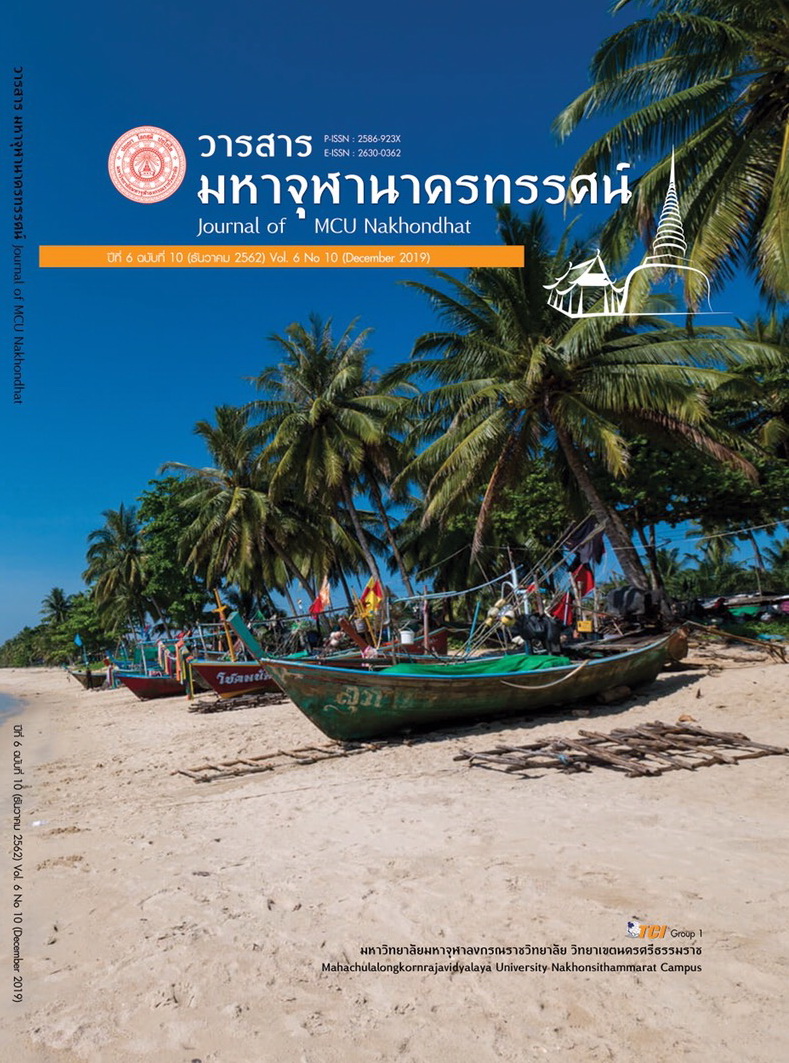THE ADAPTATION PROCESS OF THE THA-SAAN COMMUNITY IN THE MIDST OF INDUSTRIAL SOCIETY
Main Article Content
Abstract
This research aims to study the cultural adaptation processes of the Tha-saan community in order to contribute to the Tha-saan culture’s uniqueness and value. In addition, this study examines the cultural life of this community as it has existed for many years and how this culture drives local development and address issues related to capitalism.
This qualitative research mainly focuses on field research. The tools used for collecting data are: (1) participant observation; (2) key-information interview; (3) information interview; and (4) participatory filed survey for obtaining important data involving food culture and people living including knowledge conservation in local wisdom about settlement and commerce that showing the Chinese-Thai ethnic identities, lived in Bangpakong river.
The results show that the Tha-saan community has gathered itself to establish “Community Enterprise Courtyard” under the Community Economy concept and Local Wisdom. Moreover, the development of Community Tourism was emphasized to be outstanding activities, which attracted many tourists from the outside that contrubute income as well as cultural value conservation. Furthermore, through the community education system and cooperative activities, members of the community learn the community history, significant traditions. Also growing tourism trends for this community offer an opportunity for higher income and the further preservation of the community’s culture.
Therefore, the adaptive attributes of the Tha-saan community are applied to sell the local products in markets and conserve important cultural aspects such as the wooden house community.
Article Details
References
ฉัตรทิพย์ นาถสุภา. (2541). วัฒนธรรมหมู่บ้านไทยในอดีต. กรุงเทพมหานคร: สำนักพิมพ์สร้างสรรค์.
ดไนยา ก้อนแก้ว. (2551). วงโปงลางสะออน การปรับตัวทางวัฒนธรรมในกระแสโลกาภิวัตน์. ใน ศิลปศาสตรมหาบัณฑิต สาขาวิชาไทยคดีศึกษา. หาวิทยาลัยมหาสารคาม.
นงลักษณ์ รักราวี. (11 พฤษภาคม 2559). ชุมชนท่าสะอ้าน ตำบลท่าสะอ้าน อำเภอบางปะกง จังหวัดฉะเชิงเทรา. (นฤมล อนุสนธิ์พัฒน์, ผู้สัมภาษณ์)
นริศรา จันทร์อี่. (2548). การเปลี่ยนแปลงวิถีชีวิตชุมชนคลองรางจระเข้ ในการจัดการท่องเที่ยวแบบโฮมสเตย์ อำเภอเสนา จังหวัดพระนครศรีอยุธยา. พระนครศรีอยุธยา: มหาวิทยาลัยราชภัฏ.
นฤมล อนุสนธิ์พัฒน์. (2559). การมีส่วนร่วมของพลเมืองในการจัดการการท่องเที่ยวจังหวัดพระนครศรีอยุธยาเปรียบเทียบกับจังหวัดน่าน. ใน ดุษฎีนิพนธ์ปรัชญาดุษฎีบัณฑิต สาขาวิชาบริหารรัฐกิจและรัฐประศาสนศาสตร์. มหาวิทยาลัยรังสิต.
น้ำทิพย์ ภูธนชัย. (2550). การปรับตัวทางวัฒนธรรมของกลุ่มชาติพันธุ์ไทยโซ่งบ้านตลาดควาย อำเภอจอมบึง จังหวัดราชบุรี. ใน ศิลปศาสตรมหาบัณฑิต สาขาไทยศึกษา. มหาวิทยาลัยราชภัฏธนบุรี.
บุญเทียน ทองประสาน. (2531). แนวคิดวัฒนธรรมชุมชนในงานพัฒนา. กรุงเทพมหานคร: สภาคาทอลิกแห่งประเทศไทยเพื่อการพัฒนา.
โศจิลักษณ์ กมลศักดาวิกุล. (2556). ตลาดย้อนยุคสามชุก : การเมืองเรื่องพื้นที่ธุรกิจแห่งการถวิลหาอดีต. ใน ศิลปศาสตรดุษฎีบัณฑิต สาขาวิชาศิลปวัฒนธรรมวิจัย. มหาวิทยาลัยศรีนครินทรวิโรฒประสานมิตร.
สุพัตรา สุภาพ. (2541). สังคมไทยและวัฒนธรรมไทย ค่านิยม ครอบครัว ศาสนา และ ประเพณี. กรุงเทพมหานคร: ไทยวัฒนาพานิช.
สุพิศวง ธรรมพันทา. (2543). พื้นฐานวัฒนธรรมไทย. กรุงเทพมหานคร: ดี.ดี.บุ๊คสโตร์.
อานันท์ กาญจนพันธุ์. (2538). วัฒนธรรมและการพัฒนา : มิติของการสร้างสรรค์. กรุงเทพมหานคร: สำนักวัฒนธรรมแห่งชาติ.

